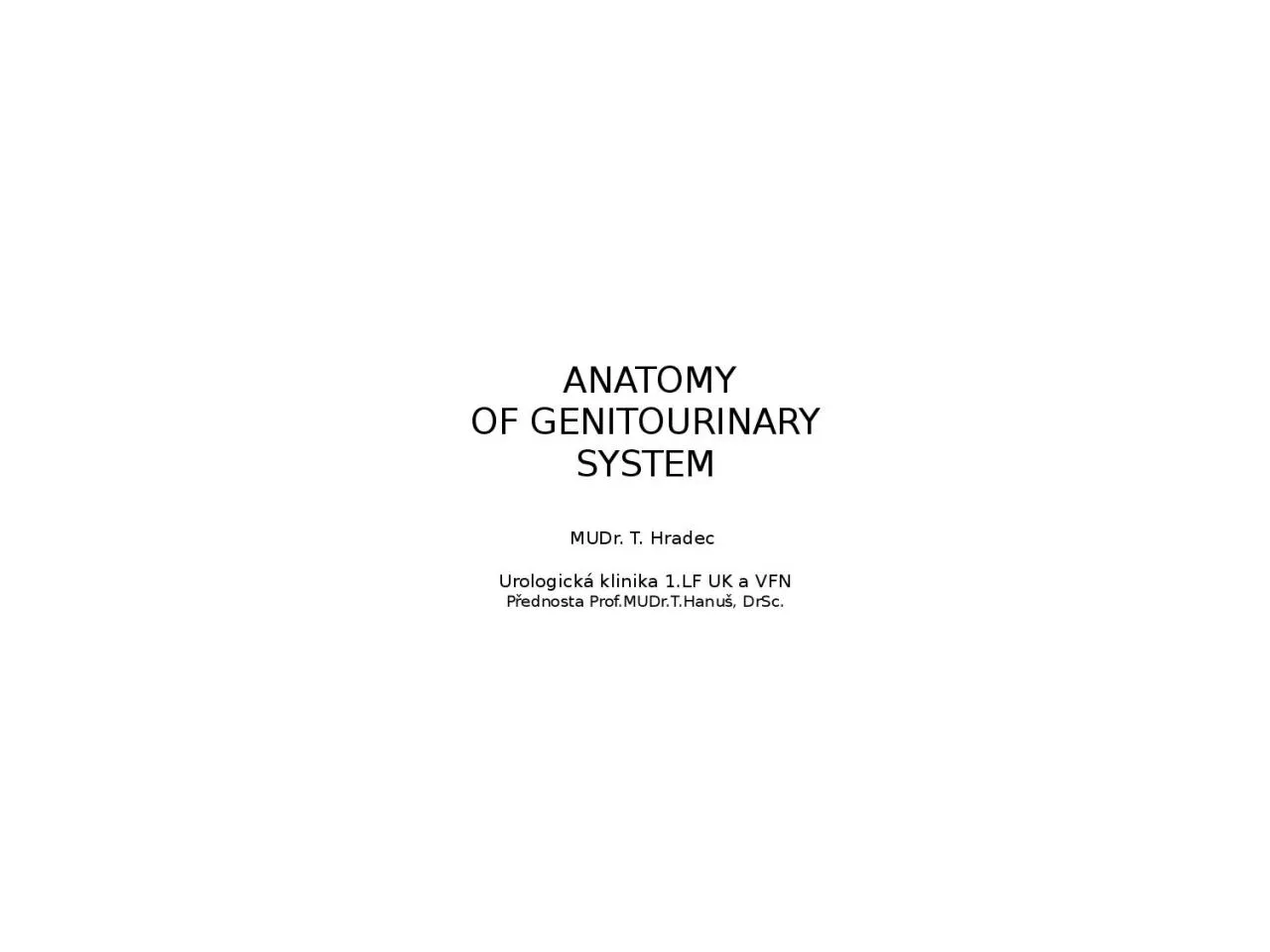

SYSTEM MUDr T Hradec Urologická klinika 1LF UK a VFN Přednosta ProfMUDrTHanuš DrSc Genitourinary system Kidneys adrenal glands Upper urinary tract calices pelvis ureter Lower urinary tract urinary bladder urethra ID: 934308
Download Presentation The PPT/PDF document "ANATOMY OF GENITOURINARY" is the property of its rightful owner. Permission is granted to download and print the materials on this web site for personal, non-commercial use only, and to display it on your personal computer provided you do not modify the materials and that you retain all copyright notices contained in the materials. By downloading content from our website, you accept the terms of this agreement.
Slide1
ANATOMYOF GENITOURINARYSYSTEMMUDr. T. Hradec Urologická klinika 1.LF UK a VFNPřednosta Prof.MUDr.T.Hanuš, DrSc.
Slide2Genitourinary systemKidneys, adrenal glandsUpper urinary tract- calices, pelvis, ureter Lower urinary tract- urinary bladder, urethraMale genital organs- prostate, seminal vesicles, penis, scrotum, testes, epididymis
Slide3Slide4KidneysretroperitoneumTh12-L2right kidney lower- liverfacies anterior/posterior
margo medialis (concave)
lateralis (convex)
extremitas superior/inferior
renal capsula – fibrous tissue
p
erinephric fat
r
enal fascia (Gerota)
Slide5KidneysCortex- nephronsMedulla- renal columns, pyramids, collecting ducts, papillaCalices- minor and majorPelvisRenal hilum
- ureter - renal artery
- renal vein
- hilar fat
- lymphatic tissue (
nodes
)
Blood
supply
- renal artery (aorta) - accesory renal artery (30%) - renal vein (vena cava inf.)
Slide6Slide7Slide8Injuries to the Kidneys - Classification
Slide9grade I: contusion or non-enlarging subcapsular perirenal haematoma, and no lacerationtreatment: hydration, observation
Slide10grade II: superficial laceration <1 cm depth and does not involve the collecting system (no evidence of urine extravasation), non-expanding perirenal haematoma confined to retroperitoneum
Slide11grade III: laceration >1 cm without extension into the renal pelvis or collecting system (no evidence of urine extravasation)treatment: observation in stabilisated cases surgery in hypotension, increasing
hematoma, massive hematuria, shock
Slide12grade IVlaceration extends to renal pelvis or urinary extravasationvascular: injury to main renal artery or vein with contained haemorrhagesegmental infarctions without associated lacerationsexpanding
subcapsular haematomas compressing the kidney
Slide13grade Vshattered kidneyavulsion of renal hilum: devascularisation of kidney due to hilar injuryureteropelvic avulsionscomplete laceration or thrombus of the main renal artery or vein
Slide14Renal cell carcinoma
Slide15Slide16Clamping of segmental artery
Slide17Slide18Slide19Slide20Upper urinary tractUreter 25–30 cm 2-4 mm
transitional epithelium
smooth muscle (peristalsis)
Ureter narrowing
(
impaction of
kidney stones)
-
pelvouteric
junction
bifurcation of the iliac arteries ureterovesical valve In females, the ureters pass through the
mesometrium
and under the uterine arteries
Slide21Slide22Slide23Congenital hydronephrosisUreteropelvic junction (UPJ) obstructionUreterovesical junction (UVJ) obstructionPosterior urethral valves (PUV)UreteroceleVesicoureteral
reflux
Slide24Congenital hydronephrosisUreteropelvic junction (UPJ) obstructionUreterovesical junction (UVJ) obstructionPosterior urethral valves (PUV)UreteroceleVesicoureteral
reflux
Slide25Congenital hydronephrosisUreteropelvic junction (UPJ) obstructionUreterovesical junction (UVJ) obstructionPosterior urethral valves (PUV)UreteroceleVesicoureteral
reflux
Slide26Congenital hydronephrosisUreteropelvic junction (UPJ) obstructionUreterovesical junction (UVJ) obstructionPosterior urethral valves (PUV)UreteroceleV
esicoureteral reflux
congenital abnormality
–
distal
ureter
balloons at its opening into the bladder, forming a sac-like pouch
Treatment
-
endoscopic incision, which can be followed by surgical
ureteric
re-implantation
Slide27Congenital hydronephrosisUreteropelvic junction (UPJ) obstructionUreterovesical junction (UVJ) obstructionPosterior urethral valves (PUV)Ureterocele
Vesicoureteral reflux
Insufficiency
of
uretero
-
vesical
occluding
mechanismTreatment - endoscopic injection of dextranomer or hyaluronic acid- surgical reimplantation
Slide28Anatomy of the collecting system and kidney stones
Slide29ureter X a. uterina
Slide30Urinary bladder
Slide31Urinary bladderLocation (Males)- between the rectum and the pubic symphysis- separated by
rectovesical excavation-
superior to the
prostate
Slide32Urinary bladder
Slide33Urinary bladderLocation (Females)inferior to the uterus separated by vesicouterine excavationbetween the
vagina and the pubic symphysis
Slide34Urinary bladder
Slide35Epicystostomy
Slide36Bladder cancer - urothelial cell carcinomaNon muscle invasive bladder cancer: pTa-pT1Muscle invasive
bladder cancer: pT2-pT4b
Carcinoma
in
situ
Slide37Non muscle invasive bladder cancer: pTa-pT1Treatment: TURBT (transurethral resection)
Slide38Non muscle invasive bladder cancer: pTa-pT1Treatment: TURBT (transurethral resection)
Slide39Bladder perforation
Slide40Muscle invasive bladder cancer: pT2-pT4bTreatment radical cystectomy + lymphadenectomyMen: bladder, prostate, seminal vesicles, and surrounding lymphWomen: bladder, ovaries, fallopian tube, uterus, cervix, anteriorpart of the vagina, and surrounding lymph nodes
SURROUNDING LYMPH NODES ???
nodi
lymphatici
i
liaci interni a externi
Slide41Upper urinary tract tumorsurothelial cell carcinoma 95%diagnosis by CT urography
higher incidence in patients
with
bladder
tumor
because
of
the
same epithelial liningtreatment: nephro-ureterectomy
Slide42Inervation and functionInervationSympathetic via plexus hypogastricus inferoir (L1–L3) m. sphincter
uretrae
internus
Parasympathetic
via pelvic splanchnic nerves (S2–S4)
m.
detrussor
vesicae
urinaeSensitive (L2–S2)
Slide43Slide44TreatmentDetrusor overactivity: anticholinergics, botoxDetrusor underactivity: parasympathomimetic - Distigminenausea, diarrhoea, vomiting, bradykardia Sphincter overactivity: alphablockers
Sphincter underactivity: surgical
treatment
Slide45Surgical treatment of urinary incontinence
Slide46Male urethra12-25cmpars intramuralispars prostaticapars membranaceapars spongiosa - bulbar - penile
Slide47Male urethraPars intramuralis (transitional epithelium) - preprostatic urethra Pars prostatica (transitional) Seminal colliculus - ejaculatory ducts (vas deferens, seminal vesicles)
- prostatic ducts - prostatic utricle
Pars membranacea
(pseudostratified columnar)
-
1
-
2 cm
-
passing through the
external urethral spincter
- narrowest part of the urethra
Slide48Male urethraPars spongiosa15–16 cm in lengthPseudostratified columnar epith. - proximallyStratified squamous epith. - distally through the corpus spongiosumexternal urethral meatusbulbar, penile (bulbous, p
endulous)
Slide49Female urethra-4cm slightly curvedventraly from vagina
- Inervation: Pudendal n.
2/3
transitional
e
pithelium
-
1/3 stratified squamous epithelium.
Slide50Prostate
Slide51Prostatic secretionsproteinsimple sugarsproteolytic enzymesprostatic acid phophatasebeta-microseminoproteinprostate specific antigenzinc Fluidity of
the semen, better motility of
spermatozoa
,
longer
survival
,
protection of the genetic material
Slide52Prostate - zones
Slide53Prostate zonesPeripheral zone (70%) sub-capsular portion of the posterior aspect ofthe prostate gland that surrounds thedistal urethra70–80%
of prostatic cancer!!!
Slide54Prostate - zonesCentral zone (25%)surrounds the ejaculatory ducts2.5% of prostate cancers although these cancers tend to be more aggressive and more likely to invade the seminal vesicles
Slide55Prostate - zonesTransition zone (5%)surrounds the proximal urethra responsible for Benign Prostatic Hyperplasia
10–20% of prostate cancers
Slide56Prostate - zonesAnterior fibro-muscular zone (5%)composed only of muscle and fibrous tissue
Slide57Prostate - lobesAnterior lobe (isthmus)Lateral lobesMedian lobe
Slide58TransUrethral Resection of the Prostate
Slide59TURP vs. Radical prostatectomyTURPbenign prostate hyperplasiaendoscopic removal of transitory zone adenomarisk of prostate cancer persistsRadical
prostatectomysurgical removal of the entire prostate gland, the
seminal
vesicles
,
and
the
vas
deferensvesicourethral anastomosis